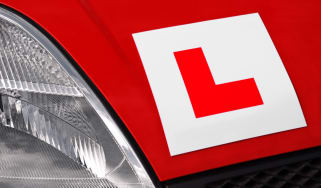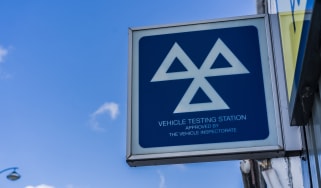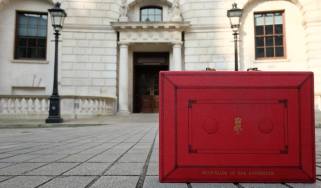How to get cheap car insurance for young drivers
Truly cheap car insurance for young drivers is rare in this day and age, but with these tips you can certainly save money

Cheap car insurance for young drivers is probably the number one thing new drivers would wish for if they had the chance. It’s likely that car insurance will be the most expensive aspect of your driving life until you are around 25, since it often costs more than the car it’s applied to.
There are many reasons why this is the case, and we’ll explain more below. It can feel unfair that even the cheapest cars to insure will cost thousands for young drivers, but remember that all drivers went through the same thing at the start of their journey and that premiums do come down over time as you build experience and a no claims bonus. Nevertheless, car insurance costs have climbed steadily across the board in recent years so nobody is feeling the pain more than new drivers.
Despite all of this, you shouldn’t give up too easily when trying to find cheap car insurance, since there are ways to save money and in some rare cases you might even find cover you could describe as cheap. In this article we’ll look at how you can do that with a bit of attention to detail and considered choices.
There are plenty of ways you can reduce your car insurance costs and many of our tips apply not just to young drivers but to everyone with a car. Your main tool will be the many comparison sites where you can get insurance quotes quickly and easily to see how small changes can reduce your premiums.
Why is car insurance for young drivers expensive?
It’s just a fact of life that the under 25s (and the over 70s) pay more for car insurance; you can’t really cheat the system and get cheap car insurance at a young age. There are reasons why car insurance has become so expensive for everyone in general but the fact that young drivers are more likely to be in an accident has never changed and probably never will - it’s the main reason why they pay so much more.
Ways to decrease your car insurance costs
There are ways you can reduce your insurance premiums, some of which are more obvious than others. However, none will be effective unless you’re prepared to put some sensible hard yards in, both on the laptop and once you’re up and running behind the wheel.
Add an older named driver
Firstly, if you name an older driver on your policy, a parent, for example, many insurance companies will charge you less for your cover. Remember that this doesn’t work the other way round: whoever has most use of the car should be the named driver on the policy. Insuring a car in a parent’s name and then adding the young motorist as a named driver, knowing full well that they will be driving the car most often, is known as fronting. It could lead to an invalid insurance policy and could also land you in court.
Get an annual policy
Two, save up and go for an annual policy rather than paying by monthly direct debit. It won’t cut your costs by a huge amount, but any saving is useful. Follow these two steps alone and you could save hundreds overall.
Black box insurance
Three, drive better and get rewarded for it. The best way to do this is by going for a black-box policy, where the insurance company fits a GPS device to your car that monitors your driving habits and reduces the policy accordingly. It sounds a bit Big Brother, yes, but if it reduces your premium, either immediately or when you come to renew, it could be the discount that puts cover for a more desirable car within reach – and it needn’t be forever, either, because a few years’ proven good driving with a black box can bring standard premiums down.
However, be aware that not all black-box policies are the same, plus there are some nasty hidden costs that can apply. Some companies will charge more to install a black box than others, while others will also charge to remove the device if you change policy. And while outright curfews are rare, black-box policies often bring higher costs if you frequently drive at night, while all companies will penalise what they deem to be bad driving – think speeding, sudden braking and hard cornering. So remember: a black box policy could be a great way of saving money if you drive well and stick to the rules. But they could increase your insurance costs, both now and in future, if you continuously flout them.
Agree to a higher excess
Four, you can also reduce your premiums by increasing the excess that you are willing to pay, although that decision could come back to haunt you if you have an accident. Remember that few altercations involving vehicles or whatever they may come into contact with are cheap.
Choose the right kind of cover
Five, similar benefits (and warnings) apply when choosing to go with third party insurance cover, or a third party, fire and theft policy. These policies used to be cheaper than comprehensive cover, but firms often now consider drivers who opt for anything other than a comprehensive policy as being higher risk. What’s more, any damage done by you to your own car won’t be covered.
Some comprehensive policies will even cover you to drive hire cars or cars owned by other people, although this is rarely included within the small print of a young driver policy. Check the details of any comprehensive insurance, because not all policies cover the same things, and the fine print can vary significantly from one company to the next.
Enter your job details carefully
Six, you will also save money by buying the right car in the first place and then by shopping around to find the best deal for your particular circumstances. The truth is, while one company will charge a 20-year-old trainee estate agent with a clean driving record £1,450 a year to comprehensively insure a 2015 Renault Clio that’s garaged overnight in Oxford, another company will charge more (or less), seemingly for no apparent reason.
Except there usually is a reason, and in this case it could be the words “trainee” and “estate agent” that send the algorithms into confusion. These computer-generated formulae analyse the risk that a customer represents, and the likelihood of the insurer having to pay out. As unfair as it seems, drivers of certain professions are, in the eyes of insurers, more likely to make a claim. Those in clerical jobs are generally regarded to be among the lowest risk, while professional sports players are far higher. You might not choose to use your actual job title when applying for car insurance, but whatever you state your profession is should reasonably reflect the work that you do. Stretch the truth and you could find your policy invalidated. Lie, and that’s fraud, plain and simple.
Shop around at renewal time
Finally, don’t go back to the same insurance company year after year. While the Financial Conduct Authority is looking into these issues, customer loyalty isn’t widely rewarded by the insurance industry. That means that if you stick with the same company, they’ll often charge you more money when it comes time to renew, not less. So once again, do shop around when you renew, because currently the most enticing deals are available to new customers, not existing ones.

What is young drivers' car insurance?
Young drivers' insurance is simply a marketing term for a product offered by insurance companies. If an insurer is trying to attract young drivers as customers then they might offer a product called young drivers’ insurance but it won’t be substantially different to anything else they offer, except that you might lose out on extras like windscreen cover or legal cover in order to reduce the price slightly. All the same terms will apply, which we’ve explained in our jargon buster below.
Excess
This is the amount you’ll have to pay if you make a claim before the insurance company will pay out. If you have a claim for £1,000 and your excess is £400, you’ll pay the first £400 with the insurer picking up the tab for the rest. Compulsory excess is what the insurer sets while voluntary excess is decided by you. Setting a higher excess will reduce your annual premium.
Fully comprehensive
These policies offer the most complete level of car insurance protection available. With comprehensive car insurance, you can claim from your insurer for accidents that are your fault or when fault can’t be proven such as when damage is sustained in a car park.
Third party
It’s the minimum amount of protection you can buy. It covers you against damage to another vehicle or structure, injuries to a third party or your own passengers, plus medical treatment cost and legal cost claims against you. Third party, fire and theft cover adds protection against someone trying to steal your car or set fire to it.
Manufacturer-backed young driver insurance deals
Car makers need sales, and getting a new driver behind the wheel is one way of doing it. But the high cost of insurance, let alone the cost of buying a brand-new car, is going to put most new drivers off going to their local dealer, unless they have the bank of mum and dad to help cover the costs.
If that's the case, there are plenty of tempting car finance deals that offer affordable ways to drive off in a new car, and the manufacturer will sometimes help to insure young drivers, too.
Do I have to pay for my car insurance up front?
Paying a lump sum up front for a whole year's worth of car insurance can be daunting, and for young drivers it will often be more than the value of their car, but it’s often cheaper than paying by a monthly Direct Debit.
Many insurers will offer monthly repayment plans or split the cost into two six-monthly payments, but the reality is you’ll end up paying more in the long run. Some insurers add up to 10 per cent onto the quoted premium if you pay monthly, while others charge interest on a monthly direct debit. If you can find the cash upfront, it’s the most cost effective way to pay.
Cheap cars to insure for young drivers
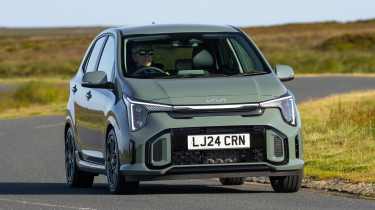
Kia Picanto
Well equipped and handsome, the Kia Picanto is an easy car to recommend. Choose any model with the non-turbocharged 1.0-litre petrol engine and insurance costs will be low, although only 2 trim with the automatic gearbox falls into the lowest group one insurance rating.
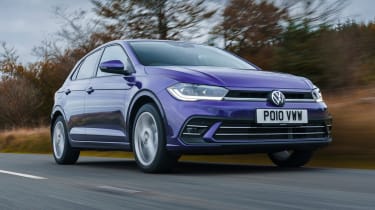
Volkswagen Polo
It’s hard to look past the Volkswagen Polo if you’re after a well built, classy first car with a bit of brand cachet. Remarkably, Match, Beats and limited-edition United trims with the 1.0 Evo three-cylinder engine fall into group one, although choosing a TSI engine will see premiums rise, with a jump to group eight.
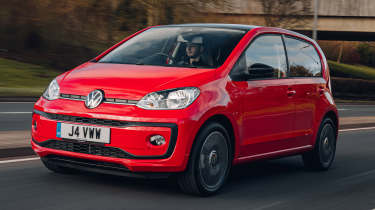
Volkswagen up!
The tiny Volkswagen up! makes for a superb first car thanks to its compact dimensions and great all-round visibility. Some models fall into insurance group two, although you can save cash by choosing one of its sister cars, the SEAT Mii or Skoda Citigo, both of which are plentiful on the used market.
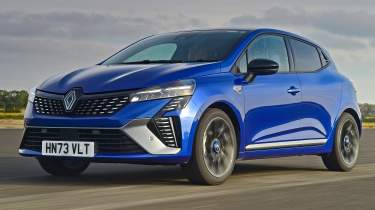
Renault Clio
Insurance costs are sometimes lower on used cars than they are on brand-new ones. So although some Renault Clio's are in group 3, it could cost you less to insure than a new car in group 2 – if you’re prepared to shop around and find the right deal.
Cheap car insurance for young drivers FAQs
Frequently Asked Questions
There isn’t a hard rule for this as there are so many factors that go into car insurance costs. Black box policies are often cheaper, but not always - use a comparison site to find out.
Tell us your experiences or trying to get car insurance as a young driver in the comments section below...
First Cars on Auto Express...

Everything you need to know about learning to drive, getting your driving licence and choosing your first car...
Learning to drive
Passing your driving test
- Driving theory test: everything you need to know
- Hazard perception test: what to expect and how to pass
- Driving test 'show me, tell me' questions: hints and tips
- Practical driving test: how to pass
- Driving test pass rates explained
- Driving test aids product test
- History of the UK driving test
Getting your first car
For all the latest car news, features, tips and advice, follow Auto Express on Twitter and like us on Facebook...
Find a car with the experts

